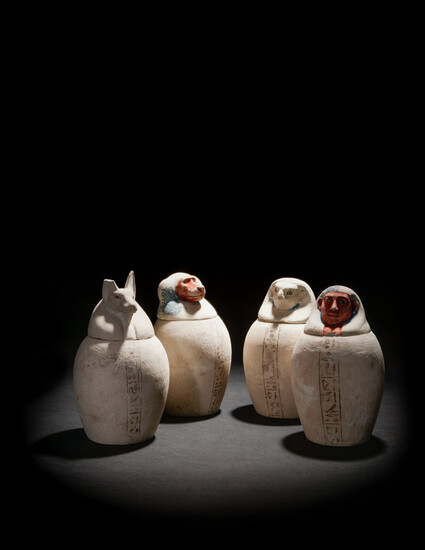A Set of Four Egyptian Painted Limestone Canopic Jars of the Sons of Horus
A Set of Four Egyptian Painted Limestone Canopic Jars of the Sons of Horus
New Kingdom, Dynasty 18, 1550-1307 B.C.
Height of tallest example 10 1/4 inches. Continental Decorative Arts
The jackal lid with losses to his ears. The jackal's body having several cracks with some fill including a portion of the inscription. The baboon's body possibly repaired, with a horizontal area of fill in the break and a larger triangular portion of fill on the backside. The falcon jar's body with a horizontal break through its upper portion with some fill, including through the inscription. Several gashes and a horizontal crack on the backside with some fill. The far right jar with minor surface cracks having some possible fill. Each with varying degrees of pigment loss, chips, scrapes, scratches and typical surface wear.
Before Joan Conway Crancer, the jars were with Bruce McAlpine. It is not known who owned them before McAlpine.
The total weight of all four jars together is 28.8 lbs.
Height of "falcon" 9 1/2 x diameter 5 inches.
Height of "jackal" 10 x diameter 5 1/2 inches.
Height of "baboon" 9 1/4 x diameter 5 1/2 inches.
Height of human jar 9 1/2 x diameter 6 inches.
Recommended shippers can provide shipping quotes prior to auction:
Mr. Shipper 847-285-1644
Navis Pack & Ship 815-630-5673
Note:
Canopic jars were used to contain the viscera, or internal organs, of the deceased. During the process of mummification, the liver, lungs, stomach and intestines were removed from the body and embalmed separately in a set of four jars, which were ultimately interred in the burial chamber with the coffin. During the Middle Kingdom, the lids of canopic jars featured human heads, but during the New Kingdom, specific organs came to be associated with the Four Sons of Horus, who were appointed by their father as guardians of the excised organs in the context of the process of mummification and the Afterlife: the liver with human-headed Imsety; the lungs with baboon-headed Hapy; the stomach with jackal-headed Duamutef and the intestines with falcon-headed Qebehsenuef (D'Auria, Lacovara and Roehrig, Mummies and Magic: The Funerary Arts of Ancient Egypt, Boston, 1988, p. 151).
Each jar in the present set is inscribed in hieroglyphs with the name of the deceased, Ipu, and the name of the depicted Son of Horus. The name Ipu was common among both men and women at the time, but the determinatives at the end of the inscriptions are male, which likely indicate the sex of the dedicatee.
Provenance:
Bruce McAlpine Ancient Art, 1 December 1992 (with invoice).
Sale price
Estimate
Time, Location
Auction House
A Set of Four Egyptian Painted Limestone Canopic Jars of the Sons of Horus
New Kingdom, Dynasty 18, 1550-1307 B.C.
Height of tallest example 10 1/4 inches. Continental Decorative Arts
The jackal lid with losses to his ears. The jackal's body having several cracks with some fill including a portion of the inscription. The baboon's body possibly repaired, with a horizontal area of fill in the break and a larger triangular portion of fill on the backside. The falcon jar's body with a horizontal break through its upper portion with some fill, including through the inscription. Several gashes and a horizontal crack on the backside with some fill. The far right jar with minor surface cracks having some possible fill. Each with varying degrees of pigment loss, chips, scrapes, scratches and typical surface wear.
Before Joan Conway Crancer, the jars were with Bruce McAlpine. It is not known who owned them before McAlpine.
The total weight of all four jars together is 28.8 lbs.
Height of "falcon" 9 1/2 x diameter 5 inches.
Height of "jackal" 10 x diameter 5 1/2 inches.
Height of "baboon" 9 1/4 x diameter 5 1/2 inches.
Height of human jar 9 1/2 x diameter 6 inches.
Recommended shippers can provide shipping quotes prior to auction:
Mr. Shipper 847-285-1644
Navis Pack & Ship 815-630-5673
Note:
Canopic jars were used to contain the viscera, or internal organs, of the deceased. During the process of mummification, the liver, lungs, stomach and intestines were removed from the body and embalmed separately in a set of four jars, which were ultimately interred in the burial chamber with the coffin. During the Middle Kingdom, the lids of canopic jars featured human heads, but during the New Kingdom, specific organs came to be associated with the Four Sons of Horus, who were appointed by their father as guardians of the excised organs in the context of the process of mummification and the Afterlife: the liver with human-headed Imsety; the lungs with baboon-headed Hapy; the stomach with jackal-headed Duamutef and the intestines with falcon-headed Qebehsenuef (D'Auria, Lacovara and Roehrig, Mummies and Magic: The Funerary Arts of Ancient Egypt, Boston, 1988, p. 151).
Each jar in the present set is inscribed in hieroglyphs with the name of the deceased, Ipu, and the name of the depicted Son of Horus. The name Ipu was common among both men and women at the time, but the determinatives at the end of the inscriptions are male, which likely indicate the sex of the dedicatee.
Provenance:
Bruce McAlpine Ancient Art, 1 December 1992 (with invoice).



